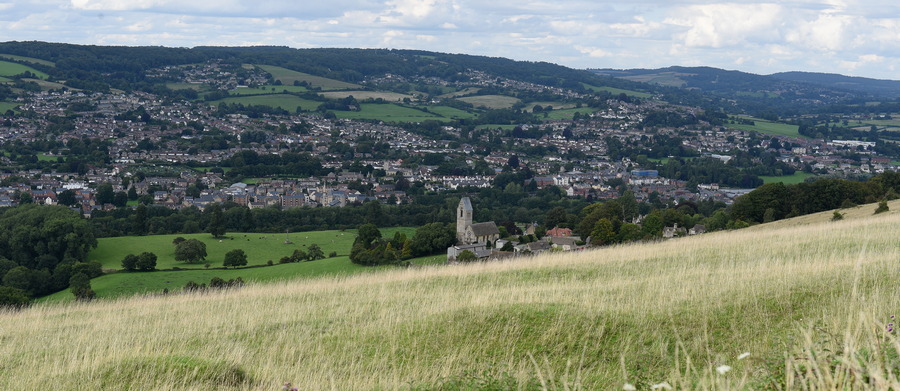Commons in the Stroud district
Selsley Common
Offering superb views over the River Severn and Malvern Hills into Wales, the Cotswold Way runs across Selsley Common. It features a Bronze Age long barrow, or burial mound, known as The Toots.
Its steep slopes are of national importance and designated a `Site of Special Scientific Interest' for their plant and animal species. The limestone was formed 180 million years ago during Jurassic times. You may see fossils of coral, shellfish and snails which sank into the mud below the sea that covered the area at that time.
Some of the Selsley Common stone was quarried and used to build walls and make lime. Large blocks were used to build nearby Woodchester Mansion.
The rare, unimproved grassland there has produced a very special ecosystem. The soils are thin and low in nutrients, so only specialised plants can survive here. You will find wild herbs and flowers like Rock Rose, Birds' Foot Trefoil, Wild Thyme, Scabacious, Harebell and Blue Milkwort. Several rare wild orchids thrive here, including Bee, Pyramidal, Common and Green Winged.
Selsley Common is home to ground nesting birds like skylarks and meadow pipits. Skylarks are classified as ‘red’ on the British Birds of Conservation Concern list which means that their population is in steep decline. In the UK, the population halved during the 1990s and continues to decline.
Enjoying Selsley Common with your dog. Selsley Common is a popular dog walking spot. From 1 March to 31 July it is a legal obligation to keep dogs on a short lead (no longer than 2 meters long), while on open access land.
There are several dog waste bins close to the road and next to the car parking areas. If you can’t find one, please take your waste home with you and dispose of it with your normal household waste.
Cows on the common. Cows graze on the common from mid-May until October. Please ensure dogs are under control and drive slowly.
The fragile habitat, its wildflowers and residents are easily damaged by the picking of flowers, litter, dog fouling and erosion of its thin soils. Please respect this special place and do all you can to conserve it for the benefit of people and wildlife. Barbeques and fires are not permitted on Selsley Common.
Selsley Common is managed by Stroud District Council.
Minchinhampton Common
Minchinhampton Common is known as a "surprise" landscape. Its Cotswold scarp top, once medieval woodland, was used by commoners needing wood for house repair and fuel. An essential part of the working agricultural landscape, some earthworks remain - the "Bulwarks" are considered prehistoric.
Quarrying took place in the fourteenth century, but three centuries later, the woodland was replaced by open limestone grassland - some of the finest in Europe and protected by English Nature.
Look out for a sealed Neolithic long barrow known as Whitefield's Tump, which gets largely obscured by summer vegetation and is where the Methodist leader preached sermons to thousands.
Minchinhampton's "Standing Stone", a piece of limestone, stands almost eight feet, with two big, natural perforations and a number of small ones. Ancient sources claim that passing a baby, arm, hand or foot through the hole, acts as a cure for rickets or smallpox.
The "Tingle Stone" just outside Minchinhampton, on Princess Anne's patrolled land in Gatcombe Park, is so-say charged with electricity. According to local tradition, the stone runs around the field at midnight!
Rodborough Common
Rodborough Common provides panoramic views of the District's secret valleys. It is also home to a number of wild flowers and butterflies. Perched on the Common's edge is a much used refuge.
Minchinhampton and Rodborough Commons cover approximately 335 hectares and are owned and managed by the National Trust. Further information can be found on the National Trust website: www.nationaltrust.org.uk
What is Common Land?
Common land is land, usually in private ownership, that has rights of common over it. It is generally open, unfenced and remote.
Rights of common can include:
- grazing sheep or cattle (herbage)
- taking peat or turf (turbary)
- taking wood, gorse or furze (estovers)
- taking of fish (piscary)
- eating of acorns or beechmast by pigs (pannage)

